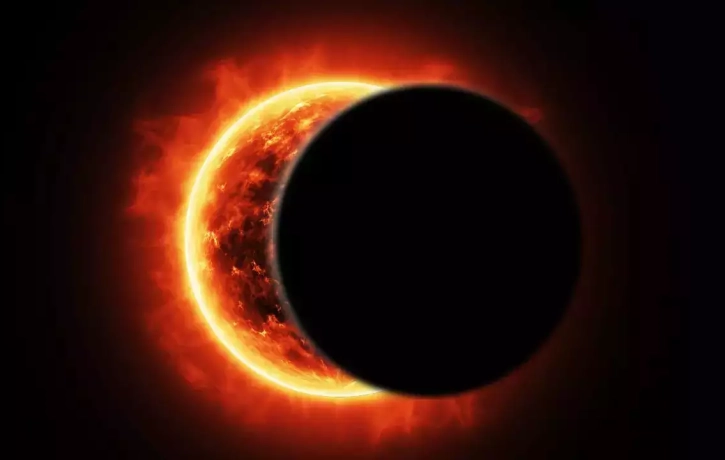Introduction
A solar eclipse, occurs when the Moon obscures a little portion of the Sun’s light so that it cannot reach Earth. Every six months, these alignments take place, but total eclipses—in which the Sun is totally obscured—are uncommon and can only be seen from a certain spot. In contrast to lunar eclipses, solar eclipses necessitate specific eye protection for safe viewing.
Solar eclipses come in four varieties
Total Every eighteen months, the faint corona—visible from a limited path on Earth—is revealed when the Moon totally obscures the Sun.
Annular The moon appears smaller than the sun and is surrounded by a brilliant ring that changes every one to two years.
Hybrid An uncommon eclipse that, depending on its position, alternates between total and annular.
Partial Twice a year, the Moon barely covers a portion of the Sun that is visible from a large distance.
Sun-Moon Size Dance Produces Diverse Eclipses
Because of their distance from Earth and their diameter ratios, the Sun and Moon appear to be about the same size.
Several sorts of eclipses are possible thanks to this cosmic coincidence:
Total When the moon is at its closest to Earth, it fully obscures the sun.
Annular When the moon is at its furthest from the Earth, it appears smaller and has a dazzling ring surrounding it.
Hybrid An uncommon eclipse that, depending on its position, alternates between total and annular.
Eclipse types are also influenced by Earth’s orbit; total eclipses are somewhat more common in July and annular eclipses in January.
All Eclipses Are Not Created Equal, Unveiling the Nuances
Eclipses are not all made equal! Depending on the Moon’s distance from Earth, a central eclipse occurs when the Moon’s shadow strikes the planet exactly. An annular or total eclipse can then occur. These kinds are the most striking. Non-central eclipses, in which the shadow is not perfectly aligned and produces an off-center spectacle, are much more uncommon. Fascinating facts about total eclipses include their several phases. Which include a period of totality during which the Sun’s light is totally obscured. With “first contact” denoting the beginning and “fourth contact” denoting the finish.
Decoding Solar Eclipses, A Closer Look
Alignment Matters The illustrations illustrate how the alignment of the Sun, Moon, and Earth produces various sorts of eclipses. A total eclipse happens in the dark gray region known as the umbra. Whereas a partial eclipse can happen in the lighter gray region known as the penumbra. The annular eclipse, an even more uncommon spectacle, can be seen in the dark region beyond the umbra (antumbra).
Orbital Dance and Eclipses The kind of eclipses we observe is determined by the Moon’s eccentric orbit around Earth. A solar eclipse only occurs when the Moon crosses the Sun’s path, or its nodes. As the Moon normally travels above or below the Sun during a new moon. Another factor is the Moon’s distance from Earth, at its closest point, known as perigee, it can totally obscure the Sun during a total eclipse. These reasons cause the majority of central eclipses to be annular. Meaning that the Sun appears to be marginally larger than the Moon.






